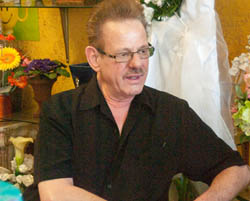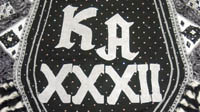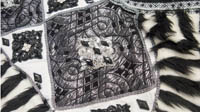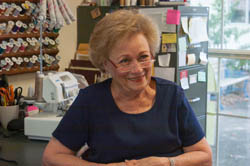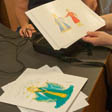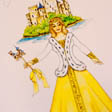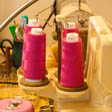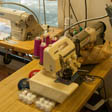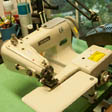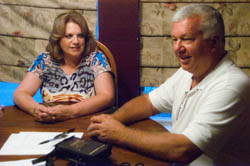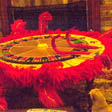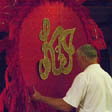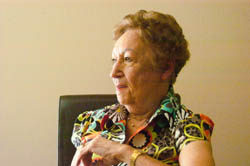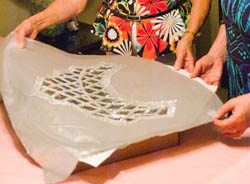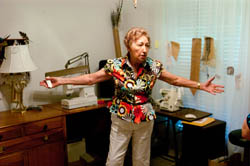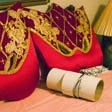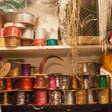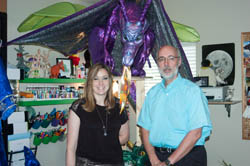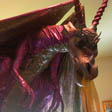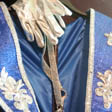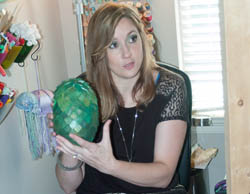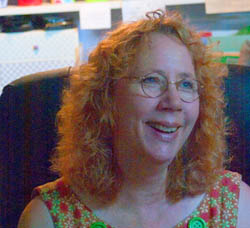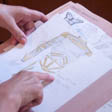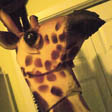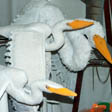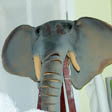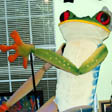Fabricating Fun: Mardi Gras Costumes in the Capital City
By Jocelyn Donlon
Introduction
There's a Mardi Gras in Baton Rouge? This is not an uncommon question, even among people who have lived in the Capital City for awhile. Except for the rather well-known Spanish Town and Southdowns parades, many residents have no idea that Baton Rouge has been home to various Mardi Gras balls for well over fifty years. The oldest krewe in the city, Krewe of Tucumcari, dates back to 1947. Since then, multiple krewes have formed around the city: Romany (1949); Iduna (1960); Mystique de la Capitale (1977); Apollo (1980); Spanish Town, including the renowned lawnmower Krewe of Yazoo (1981); Southdowns (1987); Orion (1998); Mutts (1999); and most recently, Artemis (2001).
While only a few of these krewes parade in the streets of Baton Rouge, all of the organizations—with the exception of the Mystic Krewe of Mutts, a costumed-dog parade sponsored by CAAWS—have annual balls where costumes unveiled at a tableau (the masked performance for the King and Queen) play a central role in the fun. Costumes have indeed been an essential component of carnival, around the world and throughout history. Costumes allow participants to try on an identity for the day, creating a certain freedom to "act out." In this alternative, upside-down world, normal rules are suspended in order for a community to play, in the fullest sense of the word—to play at creating an alternative identity, one which allows for ritual laughter and inebriation.
However, costumes don't come easily. Conceiving, designing, and fabricating a costume is a collaborative activity that demands attention, skill, and creativity for a large portion of the year. For some krewes, the costumes for "next year's" ball begin at "this year's" ball. The costume is part of a process that goes through conception of a theme; sketching of designs; selection of fabric and embellishments; fabrication of costumes, back pieces, head pieces, and stages; production of the ball, itself, where everything comes together; and, finally, storage of these extraordinarily large objects. Throughout the months-long process, communities form around the costume to bring the event to realization. This essay tells the stories of six people who have been an integral part of bringing Mardi Gras costumes to the Capital City for a night of celebration.
Larry Fremin
Krewe Of Apollo Founder; Carnival Captain
Before a costume can see the lights of the stage, much work must be done to conceptualize a theme for the ball. The selection of a theme falls to the Ball Captain—the "producer" of the event. Perhaps no one in Baton Rouge understands the duties of "Ball Captain" better than Larry Fremin, born and raised in Baton Rouge. Mr. Fremin helped to establish the Krewe of Apollo in Baton Rouge—a "brother" krewe to Apollo in Lafayette. The Mystic Krewe of Apollo, a gay male krewe, was founded in New Orleans in 1969, and spin-off organizations followed. While the New Orleans krewe no longer exists, having been devastated by the AIDS crisis, the Krewe of Apollo de Lafayette, founded in 1976, still celebrates with a lavish annual ball, as do the krewes in Shreveport and Birmingham. Mr. Fremin was at the first Lafayette ball; after several years of driving with friends across the Atchafalaya Basin to costume with friends, he helped to found the Krewe of Apollo in Baton Rouge in 1980. For the past thirty-five years, he has served in several capacities: founder, fundraiser, president, ball captain, king, player, and attendant.
Mr. Fremin's primary role in Apollo is to ensure that there is enough money to put on a ball. Today, the cost of a two-hour ball at the Baton Rouge River Center might run over $100,000. The Krewe of Apollo gets most of their money through fundraising events and corporate sponsors. Because he works so hard at organizing the ball, he says he's "not the person that spend(s) every night working on the costume." However, when it comes to Apollo, he is in a minority. The members are known for their extravagant costumes. Mr. Fremin says, "Sometimes the captains' ideas exceed realistic expectations, and they have to be brought back down." He recalls that the first captain "wanted to fly in." Mr. Fremin told the ambitious captain, "You're not Garth Brooks; you can't fly across the arena. There's no way to make that happen." He agrees that "the costume itself" makes their balls more extravagant than some of the others. First, he says, their members "can afford it; they're not typical family men raising kids in private schools." They might spend $5000 on a costume.
The annual ball begins in October, when the krewe elects a captain for the ball a year from the following January. The captain will spend October-February putting together a theme. Their themes have run from The Old South at the first ball in 1981 to Phantom of the Opera in 1990 to It All Began With This at their forthcoming 35th Anniversary Ball in 2016. Because the krewe works so far in advance coming up with a theme, the captain at the ball for the current year is ready to present costumes for the following year's ball. After the captain decides on a theme, members go to Carol Guion [see below], who produces the sketches and helps to fabricate the costumes. At the first meeting of the new season, Mr. Fremin shows the board the sketches, getting members to pick the sketch they want to use for their costume. Apollo is different from other krewes in that any member who wants to be on the court is allowed to do so. As for gender roles, he says that the costumes are usually "fifty/fifty" in that 50% wear female costumes, and the other 50% wear male. They "try to keep a balance." Some members have said, when there were "too many female impersonations in the ball," that it was a "drag ball." They usually have anywhere from ten to twenty costumes in a ball, ranging from minor to major. A minor player might want to be onstage without an elaborate costume, so he will get connected with a major player, who might go on stage with three to four other people. The group on stage will do a production number accompanied by music.
Mr. Fremin recalls fondly his costume for Apollo's first ball in Baton Rouge. The theme of the first ball was The Old South. As the first king, Mr. Fremin played the role of Rhett Butler. All the "girls" were in "the big Southern gowns." Mr. Fremin's costume was a jeweled green and white tuxedo, with a king's crown. The piece de resistance was that Mr. Fremin had a model steamboat on the back of his train. At the time it was considered very elaborate then, though Mr. Fremin now thinks "there wasn't that much to the costume." Photos are archived in the Baton Rouge Room Digital Archive's Mystic Krewe of Apollo Collection.
One of Mr. Fremin's best memories of the first ball was that a friend of his, who was secretary to Governor Buddy Roemer at the time, offered to let him take his portrait at the Governor's Mansion. The friend told him, "He [Gov. Roemer] is out of town a lot, and his wife loves to let different king and queens from other krewes throughout the state come take their picture here in the Governor's Mansion." Thus, Mr. Fremin's official portrait was on the grand stairway of the Governor's Mansion, complete with the State of Louisiana seal at his feet. He says, "It was kind of cool to think that we were able to do that 35 years ago."
Mr. Fremin has been surprised at the acceptance of Apollo throughout the years. He was particularly surprised when the Krewe first formed in 1980. Their first members were, he recalls, "twenty-five guys in Baton Rouge: . . . a member of the state police, . . . a secretary in the governor's office. These people were basically what we would call now `closeted gay men.'" The members would only participate in the first balls if they wore masks to keep their identity from being publicly exposed. However, Mr. Fremin says, "That lasted through the first ball, and we've never worried about a mask since." At the first ball, when the queen came out, "she said, `Larry, this is so well accepted, throw these masks down." So Mr. Fremin was the "first to take the mask off," and he says, "We never looked back again."
At the forthcoming ball in 2016, the king will do a post-modern retrospective and dress as Mr. Fremin dressed at that first gay ball in Baton Rouge. Mr. Fremin will be honored as "Captain Emeritus." It promises to be a grand occasion.
Carol Guion
Costume Designer And Fabricator
Carol Guion's name is mentioned frequently in reference to Baton Rouge Mardi Gras. She is a seamstress who has worked with Mardi Gras krewes for well over a decade. Having taught herself as a child to sew doll clothes, she later made her own clothes. She admits now that, as a teenager, she would take ready-made clothing out "on approval," use newspaper to cut a pattern, and then return the original to the store. "It's called `desperation,'" she acknowledges. Her "desperation" to make an item of clothing work has served her well during Mardi Gras, where she sometimes pushes the envelope when designing costumes.
Carol Guion began her paid costume work with the Baton Rouge Little Theater, in the 1990s, where she was "resident costumer" for several years. She first began to work with Mardi Gras costumes in 1991 for the Krewe of Apollo. About seven years ago she started sewing for the Krewe of Iduna, an all-female krewe in Baton Rouge. Her work for the season begins when the ball captain comes to her with a theme, although she has occasionally been with krewe members as they brainstorm. She recalls a time when she was on a shopping trip with a ball captain of Iduna, who knew she wanted something medieval but couldn't think of a theme. She says, "We were sitting in the hotel room, and of course it's like a bunch of hens cackling the whole time, and all of a sudden it just dawned on me—Oh, What a Knight." The king and queen were Arthur and Guinevere. For the coming year (2016), The Krewe of Iduna will have six maids, as well as a king, queen, ball captain, and four pages (two female, two male). Ms. Guion will make every single costume, with the help of her volunteers.
One family in Baton Rouge shows up every year in what Ms. Guion calls "the clown car" to volunteer to help with the costumes. She recalls the first time they came, the whole family, some of whom were members of Iduna, arrived. But Ms. Guion thought only two people were coming: "They go as a caravan. People came out of that car! I said, `Is it gonna stop?'" Now they come every year to work—for fun. "One of them comes right at noon, and says `what's to eat' and heads for the kitchen, so we just wave her through." At the time of our interview, Ms. Guion said they were "pestering her" about when they can start working for the upcoming ball. They come most every Monday once the embellishment of costumes begins. "They love it," she says. She acknowledges that "it's sort of insane" on Mondays; in fact, once they start coming, she never plans anything on Mondays. Clearly, the sense of community is as important as the costume.
Another woman shows up because "she wants to sew." Ms. Guion says that "it's not work for them like it is for me." She has to consider other elements, such as body shape of the person and what would look best on them, as well as making sure the fabric is cut to fit. She does the cutting herself so that she can worry less about something being "cut wrong," which she says causes "terror and panic."
Her work all begins with lovely, watercolor drawings of possible costumes. Her watercolor sketches are artworks, in and of themselves. (In her early years, she wanted to be a commercial artist, but she never received any formal training.) While the original sketches are valued objects, she keeps only copies. The krewe usually gives the originals to the people who serve on the court.
After krewe members approve the sketches, Ms. Guion begins searching for the best materials. When searching, she says that she has to consider the effect of the "white hot" lights on the colors, which can easily be washed out. She looks for fabrics that, under the lights, will be true to the design in the sketch. Ms. Guion says the "hard part" is finding the fabrics. She likes to use good quality velvet and stiff satin linings. One of her favorite fabrics is faille, which she says is hard to find. She likes the luster of the fabric which changes with the lights. For sparkle, she resists using lightweight fabric with glued-on sequins because it ruins her machine needle. She will use actual sequin fabric—with sequins sewn in. She also likes metallic brocades because of how they look under the lights. Recently, she says that members want hologram fabrics that change colors with the light.
To find these fabrics, she, with members of the "Clown Car" family, often take road trips. They will go to Gulfport, to New Orleans, and when she "gets desperate," she will pile a "bunch of crazy women in a bunch of cars" and "head for Houston," which has all the "fancy stuff," such as sequin laces and feather fabrics. In addition, she has been using the Internet about five years. Before that it was "just praying that you could find something." She only buys online when she knows what she's buying, or she orders samples to feel the texture.
In addition to using fabric glue, she says she once used "contact cement" for Apollo krewe members to make a muscled-body suit. She fitted the men in a leotard, then carved foam to create a muscle suit with "big chest pecs and big biceps." She sprayed glue and applied the pieces of foam to the leotard for muscles. Then she used a second body suit to fold and shape the muscles. The man who played Thor was, in reality, quite small, but the body suit was so effective that, at the ball, Ms. Guion overheard a woman saying "look at the build on that guy."
While Carol Guion designs back pieces and head pieces, she does not fabricate them. For that, she turns to Bo and Patty Stepp of Baton Rouge, who say that "Carol really pushes the envelope." She challenges them to achieve such feats as casino wheels that perpetually spin. Bo says that she'll imagine something and say, "I drew it; you gotta do it!"
Bo and Patty Stepp
Backpiece and Headpiece Fabricators
Bo and Patty Stepp have been working with the Krewe of Apollo and the Krewe of Iduna for about a decade, first making head pieces and later, back pieces. Patty Stepp is a long-time member of Iduna, so Bo Stepp was originally involved in the Krewe through her. He became more involved when, in 2005, the ball captain asked him to make the back pieces and head pieces for her ball. He was hesitant as first, but he soon discovered that it "brought out the artist" in him.
Bo Stepp says that he has been mechanical all his life. As a teenager, he constantly tinkered with cars, which led to him owning his own automobile repair shop for seventeen years. The skills that made him a good car repairman are the same that make him a successful costume fabricator.
The first year that Mr. Stepp worked for Iduna, he made a head piece that was a Venetian sailing ship. He made the sails out of wire and fabric, and then covered the sails with crystals. It was very heavy, but Ms. Stepp says, "It was gorgeous when the lights hit it." Mr. Stepp still thinks "it's the prettiest that [he's] ever done." However, head pieces are not only heavy; "they are a pain to make," he says, because they have to be fitted to a head. He recalls when a girl was so small, that she couldn't support a head piece, so had to make a brace to go up the back.
After that first year, Bo Stepp, along with Carol Guion, persuaded the members to go with back pieces. Ms. Guion will sew a corset-style vest with pockets in the back, and Mr. Stepp will fabricate the back piece to be fitted into the pocket. The corset can be laced tightly so that the wearer's back and shoulders are supporting the piece. In Iduna, the maids will wear "a little something" on their heads, and the Stepps also make matching hand pieces to go along with the costume. But the glory comes from the back piece.
To fabricate the frame for a back piece, Mr. Stepp uses an acetylene torch to weld quarter-inch steel rods, cold-rolled, which he says are "a lot stronger than hot-rolled." He also uses a sautering gun and "a lot of hot glue guns." After he builds the frame, he covers it with whatever material the costume calls for—sometimes an opaque, translucent material—"which is really hard to do to make it look right." The collar has to match the curvature behind the head. Sometimes he covers the wire with cardboard covered with material. After the frame is covered with fabric, he and Ms. Stepp "start slunging it up" and decorating. Slung is "a material with a lot of different colored sequins in it," basically sequin bordering material about one-half inch wide. Mr. Stepp says that slung "gives a nice, bright effect when you see it under the lights." Patty does most of the embellishment. She uses appliques, and will cut lace out of fabric and glue it onto the costume. Then she "stones" the costume with jewels. Mr. Stepp explains that envisioning the costume under the lights" is integral to its design and fabrication. You want it "to literally shine." He uses microfine glitter which is "great for back pieces." He says they "have glitter everywhere" in their house during the season. The Stepps both agree that it's worth it because "under the lights it looks phenomenal."
Inevitably, ball captains compete to “outdo” the previous ball. When Patty was ball captain in 2008, the Stepps were challenged to come up with something extraordinary. As is typical, the theme had to come first. On a drive to Mississippi, they decided on cruising; with such a theme, a ship could stop at different ports. Patty's entrance at the ball also had to be spectacular. Inspiration was found at church, when, sitting through a sermon, Bo leaned over to Patty and said, "I know how you're gonna come in!" He took a non-functioning ski boat that had been abandoned at his auto repair shop, and he cut the bottom out of it. Then he placed the boat over a golf cart that had a rack on the back for Patty to stand on. As the boat entered, the crowd heard the sounds of a recorded motor of a "Detroit Diesel," which sounded like a real boat. Patty recalls, "I would go in and he would blow the horn of the boat." For her, "It was priceless, it really was."

Pleasure is at the heart of the costume experience—pleasure in having fun and pleasure in appearing larger than life. One of the "most fun" back pieces Mr. Stepp ever made was Tiger Stadium at LSU, for a member of Apollo, when the year's theme was Games People Play. For Apollo members, Mr. Stepp will occasionally make only the frame, and the krewe member will do his own decorating. But for the stadium, Mr. Stepp made it "from start to finish." He started by bending foam to get the stadium's curvature. He carved into the foam the new upper decks (the rear upper decks didn't exist at the time). He says he "cheated" by buying a stuffed tiger instead of making one. But the tiger was so heavy they had to take all the stuffing out. The stadium back piece had a goal post, with the football going over the goal post. The football is made of hollow foam in order to be as light as possible. The goalpost, the heaviest part, is made of PVC pipe. Mr. Stepp went the extra mile to put a barely-visible rod between the goal post and the football, using a small electric motor to keep the ball spinning so that "it looked like a football being kicked." The piece was about 14 feet tall—so tall they couldn't stand it up in their house. Mr. Stepp admits that he's the "first to go overboard," that like everybody else, "bigger is better."
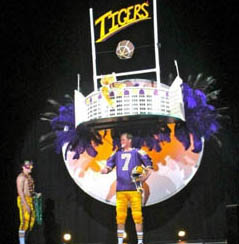
The Stepps' son and daughter participate in helping with the costume pieces. Their son does electrical work, so he steps in to help with the lighting and mechanics. Their daughter helps with embellishment. However, the children have no desire to carry on the business. Patty says, "They see how much time it takes us to do it." Bo and Patty both work full-time jobs, so all the Mardi Gras work is done after hours, from May to January, at night and every weekend. For the first time in years, they are not doing work for the Krewe of Iduna in 2016, taking a much-deserved break. However, they do hope to return to it in years to come.
Loretta Shelton
Costume FabricatorLike the Krewe of Apollo and the Krewe of Iduna, the Krewe of Romany also uses local costume designers and fabricators. Romany depends on Ms. Loretta Shelton to sew and embellish their costumes and back pieces. Loretta Shelton has lived all her 85 years in Louisiana, having been born in Plaquemine. She moved to Baton Rouge when she was thirteen and has lived in the city ever since. To learn how to sew, she was largely self-taught; she took two years of Home Economics in high school, and "made an F on zippers." When she first began sewing costumes, she started with dance costumes (1974-1977). Her Mardi Gras work began in 1977, when she received a phone call from the Krewe of Romany asking her to place a bid. She recalls the story of "that first bid" with chagrin: she bid $38 for each costume because she thought it was "a lot of money." She says, "I will never again do them [costumes] for $38 in my lifetime!" She didn't realize how much work was involved in each costume and deeply underbid. She has sewn for Romany every year since 1977, except for about eight years when "another person came in." Working eleven months out of the year, from April to February, she sews for the entire Court at their annual ball—the king, queen, ball captain, maids, and pages. When she has time, she also occasionally sews for a krewe in Plaquemine.

The Krewe of Romany provides the material and the design sketch for each costume; Ms. Shelton does only the sewing and embellishing—which she calls her "TV homework." She recalls that in the early days, mothers were "dedicated to do the embellishment on their daughter's costume." Now, "they just want it pretty," so Ms. Shelton does all the embellishment. She and court members see the sketches, which the krewe calls "la key," for the first time at the annual Tea, at which time she measures the girls. Members place a deposit early on for their costumes, and the materials are bought either in New Orleans or Houston. Ms. Shelton does not use the Internet to buy materials; she purchases them or fabricates them. Except for the "royalty," she prefers to use fabric that is not very shiny"; a matte background allows the embellishments to stand out. A new fabric is used every year, and she searches for whatever she can find that is required by the sketch.
The sketch designer for the Krewe of Romany is Todd Avery, who now lives in Florida. He paints lavish sketches, and then it is Ms. Shelton's job to match the sketch. Through the years, the Krewe has given her leeway in adjusting designs to meet the needs of individuals. She says, "The sketches look like a child wearing a size two dress. It's not feasible. You have to be able to think of a body size." She works to show each person "the pros and cons of what it can be and what it can't be." For example, for the forthcoming ball, a sketch called "Tropicana" calls for a pineapple to be on the person's head. Ms. Shelton says, "I'm not putting a pineapple on her head," so she is free to make changes.
For the first fitting, Ms. Shelton makes a "dummy pattern," which she works with "over the summer." This dummy pattern will eventually be the lining and interface of the final costume. Because of the changing nature of the girls' size at their young age, she will not cut the final pattern until after the school year starts. Once she is convinced that the pattern is a good fit, she rips apart the dummy pattern, lays it on the "good fabric," and then "sews everything back up again." If she has to put any type of embellishment on the costume, she will leave the side seams unsewn until the very end, making the job easier. By the final fitting, the dresses are completely jeweled.
The embellishments are glued on to the fabric, either with hot glue or fabric glue. As of the interview (July 2015), she has already made the embellishments that will be attached to dresses for the 2016 ball. She both purchases and fabricates the embellishments. For the forthcoming ball, a costume called for "purple embellishments," and Ms. Shelton said, "There's no such thing." She fabricated them using drapery fabric, which she sprayed with floral spray, and then cut it and jeweled it with glue. She buys most of her jewels in New Orleans, particularly Jefferson Variety. She has worked with them now for three generations of family owners.
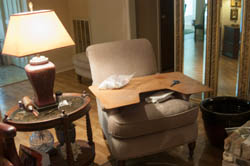
For the back pieces, Ms. Shelton uses foamcore. Like Bo and Patty Stepp, she knows that "lighter is better." It is important that the court member be able to carry the back piece comfortably. She recalls a previous year when a ball captain had butterfly wings which "were absolutely gorgeous." However, the captain was too small to carry the wings, and two stage attendants had to help her hold them up. The members have "metal harnesses that look like backpacks," and they apply the foamcore to the harness to stick the pieces in.
The costumes do not come cheaply. Ms. Shelton estimates that a ball captain's costume will cost anywhere from $1800-$2100 in supplies alone. Genuine rhinestones are very costly. A gross of them costs $144, and she will use about ten gross on this year's ball captain's dress.
Ms. Shelton says that she has tried several times "to quit," but she gets "too bored." However, this year (2016) is taking its toll because she is doing not only the dresses but also the back pieces and head pieces. She says that by next year, "the king, queen, and ball captain will be way enough." Ideally, she would love for someone else to do the sewing so that she could focus on the embellishing, which is her "favorite part." She still wants to keep her "TV homework."
Catherine Whitehead
Costume Designer And Fabricator
While Larry Fremin, Carol Guion, Bo and Patty Stepp, and Loretta Shelton are nearing the latter days of their Mardi Gras work, Catherine Whitehead is just beginning hers. As the daughter of Michael Hale, President of the Krewe of Tucumcari, Catherine has recently stepped in to lend—all her work is volunteer—her creative skills to the Krewe. In the early days, a local seamstress, Madge Gomez, made their costumes. When she passed away in 2011, the krewe turned to New Orleans. Most of the design and fabrication for the all-male Krewe of Tucumcari is done by a company in New Orleans, A Masquerade Costume. However, in the past several years, Catherine has brought her skills to the krewe, particularly to show support for her father. The two of them, together, participated in the interview for this essay because their work is so collaborative.
The Krewe of Tucumcari was formed in 1947 by three couples who had traveled to Tucumcari, New Mexico, for vacation. According to Mr. Hale, the friends, when thinking about starting a Mardi Gras krewe in Baton Rouge decided that because "they had such a great experience in Tucumcari, New Mexico," they would name their krewe in honor of it. The town in New Mexico has its own legend: "In the town, there's a story about an Indian prince and princess who fell in love with each other, but for some reason couldn't marry, and the girl ended up killing herself. The man's name was `Tucam' and the girl's name was 'Cari.'" The Krewe tells that story "all the time," but it hasn't really influenced their decisions about balls and themes.
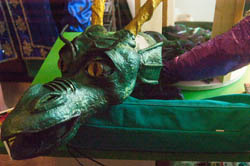
Michael Hale joined the Krewe in 1999, getting involved through a friend. He became president in 2011. Before becoming president, he was vice-president. He says that at the board meeting at which officers are elected, "Whoever is out [of the room] ends up being president." He is also the treasurer, though it is Catherine who does the books for Tucumcari (she has a degree in accounting). Catherine was a maid in the 2000 ball, when she was fifteen. The theme was Wishes, and her wish was "Love and Marriage." She wore a "huge hot pink ball gown with silver rhinestones," and her headpiece was pink ostrich plumes with a "huge wedding cake," which her father said "made her look fifteen feet tall." She didn't really have input on the costume, saying that the designers figure out what will look best on each body type.
Since 2014, Catherine has helped out with fabricating the stage at the ball, as well as designing her dad's ball captain costume for 2015. The theme was King Arthur, with court members representing characteristics of knights, such as "chivalry" or "bravery." Mr. Hale was a "time traveling ball captain"; what's more, he was the first ball captain ever to have speaking lines. Catherine wanted to turn the ball "more into a show because the guys get a little bored just sitting there watching these girls." Mr. Hale entered the ball in a cart with bubbling caldrons and dragon eggs, created by Catherine. He then initiated a conversation with the narrator. When the captain flashed his magic wand, it "spewed out glitter" that went all over the people in the crowds. All this was accompanied by music, selected by Mr. Hale, related to magic.
To decorate the stage, Catherine uses corrugated plastic sheeting from Home Depot, and then she foam-tapes the sheets together. After the sheets are taped together, she paints and glitters them, and then drapes them in fabric. Previously, stage designers would order cardboard cutouts online, but Catherine says she can make them much more cheaply and better with corrugated plastic. Catherine also made, for the stage, a rock with the sword Excalibur stuck in it. One of the kings was Arthur, and when he pulled the sword out of the rock, "the crowd went wild," according to Mr. Hale. He adds that everybody there (about 1000 people) wanted to take a photo pretending to pull the sword from the stone, which was on stage. The other king had difficulty walking, so they made a chariot for him to ride in, drawn by his nephews.
For their family/group table, Catherine fabricated a dragon's head. She knew that when they said the theme was King Arthur's court that she wanted a dragon because she's a fan of Game of Thrones. She had never made such a sculpture before, so she read online for background, and discovered how people use paper maché. She found one method that uses only newspaper and masking tape, which she had, and which was light. The dragon's head is just masking tape and newspaper. After she taped it up, she sprayed it with texturized paint, which she called "orange peel spray," to get rid of tapelines. The dragon head was complete with an electric fan inside so that it appeared to be breathing flames. Catherine explains that everybody gets to decorate their own table the day before the ball, and they can "go as crazy as they want to." She had also created a much larger dragon that was on the stage for the tableau, a skit or play performed by the krewe. She's not entirely satisfied with the orange peel spray because it cracks when touched, so for the forthcoming ball (2016) she has created a Pegasus. She used chicken wire to create a general form, "a triangular blob," and sprayed it down with foam insulation. She then carved the foam insulation to create Pegasus. She filled in holes with spackling. Her dad proudly compares Catherine to Michelangelo, "who released David from the marble."
When asked if the motivation for the tableau design was "fun" or "beauty," Mr. Hale said that since the krewe is 69 years old, they've "been on a roller coaster between those two points of `just having a good time' because you didn't have a lot of creative people involved, to now having somebody who's creative [meaning Catherine] "so that they can have a more inventive experience." Father and daughter, together, are raising the level of playful creativity, which is at the heart of the Mardi Gras experience.
Lee Randall
Costume Designer And Fabricator
When speaking of "playful creativity" at Mardi Gras, there is perhaps no krewe more playful or creative than the Krewe of Yazoo, the famous lawn mower krewe of the Spanish Town parade. Each year, about 30 krewe members decorate their own lawn mower, dress up in a fun costume, and roll through the streets of Spanish Town in choreographed moves. Lee and David Randall are at the heart of the krewe; David was a founding member in 1983, and Lee is the costume designer. They both first joined when Ted Hicks telephoned Lee and David the night before the first parade and said, "You got a lawn mower? Get an ugly hat and a tie, and meet us downtown." About seven people gathered the next day, and the Krewe of Yazoo was born. Spanish Town parade-goers often say that they go primarily to see the lawn mower krewe dance. It is the highlight of the parade. This krewe is not about a ball; it is about the streets.
While the Society for the Preservation of Lagniappe in Louisiana, the organization which governs the Spanish Town Parade, may establish a theme each year, the Krewe of Yazoo makes its own decision about whether or not they'll participate in the overall theme. If they don't like it, they follow their own path. In fact, Lee Randall tells a story about when the Krewe of Yazoo set the theme for the entire parade. In the early years, Lee and her friend came across a bag of plastic fruit while shopping, and Lee said, in reference to the forthcoming parade, "Wouldn't it be cool if we could be Carmen Mow-randa?" At that moment, Margo Hicks, who helped to start the Spanish Town Parade, turned the corner, saw them playing with plastic fruit, and when Lee said she wanted to be Carmen Mow-Randa, Margo said, "Then the theme will be Hollywood comes to Spanish Town." She chose the theme based on the Krewe of Yazoo's costume desires.
The costumes are always noteworthy. Lee, using her background in art, designs clever, funny, playful costumes for the whole krewe. While each member can decorate his or her own lawn mower, Lee oversees the fabrication of the costume. They are all made in the Randall home. After the pattern is finalized, a core group of people go to Lee and David's house to cut all the costumes for all the members. She designates tasks according to each person's skill. Lee does most of the assembling and painting of the costumes, herself. When the Krewe did Mowah's Ark, she did all the animal heads. She used a basic pattern that looked a bit like a planaria [a flatworm], and then cut the eyeholes, and fashioned each one differently. "That was fun," she says. "That was a lot of fun because I like that challenge. I like to make things that there's no pattern for." For the year that they were Amowdeus, Lee made powdered wigs for the guys from white kerchiefs with yarn sewn to them. She then took quilt batting and rolled it up in yarn and then hot glued it to the kerchief. For the women, she made powered wigs using coat hangers, elastic, and quilt batting (she says that she had not yet thought of baseball caps, which is now her go-to starting point).
To brainstorm ideas for the costume, Lee will make sketches—as do all the costume designers. Her sketches are informal, brainstorming tools rather than finished art works. Once she decides what the costume will be, she looks for photos. For example, if the costume is a crawfish, she will use a photograph of a crawfish because she wants to be accurate. Lee's "go-to" materials are "rubber foam and hot glue" because they are inexpensive and easy to work with. She has discovered heatproof gloves, so she no longer gets "third-degree burns." "It's not Mardi Gras if there's not a third-degree burn," is a common saying in their Krewe. Lee makes a prototype of the costume first, and then she makes a pattern from the prototype. Each year, they order long-sleeve T-shirts and T-shirt jersey pants, and then dye them to fit the given costume. When the krewe members were trees, for the Krewe of Mow Return, they dyed the outfit gray, cut a stencil that looked like bark, put the T-shirts and pants on people's bodies and spray-painted them using the stencil. The animal heads for Mowah's Ark were also spray painted, with Ping-Pong ball eyes. At some point, several years back, she discovered the function of using a baseball cap. She cuts the brims off and decorates the remaining cap. The people can adjust the cap to fit their own head, so she doesn't have to make headpieces to fit each member. She has also made use of Tyvek. Soon after the wall came down in East Germany, their slogan was Will Orbit for Food, and they drew straps on Tyvek. To make the packs, they used white gift boxes. Lee made a helmet out of hanging plant liners. She put two liners together, "kind of like a Pac man," spray painted them, and cut a neck hole. They put CCCP (Combined Community Codec Pack for gaming; also a left-wing political party in Russia) on top of it and marched to Russian music. There was "a lot of goose stepping," she said.
While other krewes' costumes may come in at $2000, the Krewe of Yazoo sets its annual dues at $175, to cover the costs of the costume and the fees for the parade. Lee speculates that the costume, itself, might cost around $50. Clearly, the members of Yazoo participate primarily for fun.
Conclusion
All these participants, who bring costumes to life for the celebration of Mardi Gras in Baton Rouge, share one common goal—to play and have fun within a shared community. Whether a costume is created to be beautiful, ironic, or even funny, whether it costs five thousand dollars or five dollars, these people come together to produce weeks, often months, of ritual celebration and laughter. It takes a village—or krewe—to pull the events off. Participants contribute their individual skills—balancing checkbooks, sketching designs, fitting costumes, jeweling trains, wiring back pieces, and carrying it all off on stage—to prove that their lives are about more than work. Humans must play, and at Mardi Gras, even the work to pull off the perfect costume becomes play.
Sources
Fremin, Larry. 2015. Personal Interview. Baton Rouge, Louisiana. August 2.
Guion, Carol. 2015. Personal Interview. Baton Rouge, Louisiana. July 8.
Hale, Michael. 2015. Personal Interview. Baton Rouge, Louisiana. July 9.
Randall, David. 2015. Personal Interview. Baton Rouge, Louisiana. July 9.
Randall, Lee. 2015. Personal Interview. Baton Rouge, Louisiana. July 9.
Shelton, Loretta. 2015. Personal Interview. Baton Rouge, Louisiana. July 9.
Stepp, Bo. 2015. Personal Interview. Baton Rouge, Louisiana. August 3.
Stepp, Patty. 2015. Personal Interview. Baton Rouge, Louisiana. August 3.
Whitehead, Catherine. 2015. Personal Interview. Baton Rouge, Louisiana. July 9.



